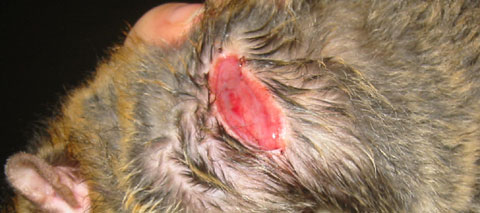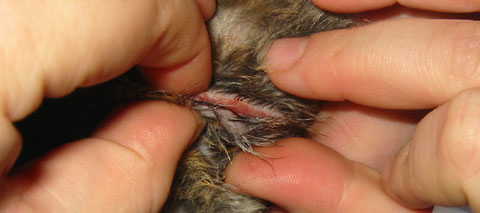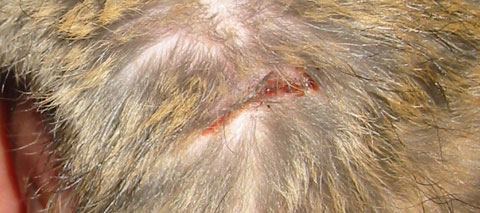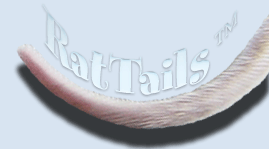
|














 
|
Skin Glue, My Hero!But it's just glue! Yes, it is just glue but when you have rats, glue is a very handy thing:
Apparently there was a full moon or something:
Someone was fighting unfairly:
What to do? What to do? The answer, my rodent-loving friends, is skin glue! Someone was fighting unfairly:
Option 1 is to leave it be: eventually the rat will chew it off. Option 2 is to drop a little glue on it to stop the bleeding and (hopefully) set the dangling nail in place (this rarely works but is worth a try). Option 3 is to sterilize some scissors to the very best of your ability (heat them over a burner until they are red and hot then allow them to cool), clean off the toe to the best of your ability (iodine, peroxide, or rubbing alcohol in order of preference) and snip off that dangling piece, pull the skin back over the toe, and glue it shut. Option 3 sounds awful, but Option 1 and 2 really aren't any nicer: Every time they bump that toe they yelp or hop around like it really hurts (probably because it really hurts). You guess wrong or apparently there's a full moon or something:
[Disclaimer #2: This does not apply to testicle bites. Those usually, if not always, will require antibiotics and depending on the size and location of the cut, it may be better to leave it open. Let the vet decide.] [Disclaimer #3: This does not apply to tail bites. Gluing a small hole on the tail will only cause it to fester more. Keep it clean, keep it dry, keep everything the tail will come into contact with immaculate, and if it still decides to become red, hot, or swollen (and thus infected), see a vet.] [Disclaimer #4: Do not apply glue to any portion of a rat's face. They wiggle and you'll get it in their eyes. It won't resolve ear cuts. It should not be placed over recently opened abscess wounds. Even if you think you have a clue as to what you're doing, if it's on the rat's face, you probably don't have as much of a clue as you think you do. There is no room for error when you're dealing with a rat's face so see a vet.] For everything else, here's what you do:
1. Take a good look at the bite wound. If it's still raw and bloody looking, it's probably a fresh wound. If you heard it happening, you know
it's a fresh wound. If it is a fresh wound, I generally don't risk introducing more bacteria into the area by touching it in any way and just glue
it directly. If it's not a fresh wound, take a cotton ball, wet it, put some soap on it (Dial is nice), and scrub it down. You want it to look
like this (namely damp, raw, and bloody):
 After it has been scrubbed down, you want to rinse off the soap (a second cotton ball, dampened and a third cotton ball, dampened, if necessary) and then you want to pat it dry (small piece of clean paper towel). Since I was dallying with the camera, I did wash Cedar's cut down which is why his fur is a little wet. The only thing I care about being reasonably dry is the pink fleshy stuff.
2a. You're ready for the glue. Prep the bottle by placing on the tip that it comes with. I'm lazy and you will see in the pictures that I'm not
using the tip. Using the tip does have its benefit as you can draw a thin line of glue but since I wanted you to be able to see what I was doing,
I chose to be lazy. Plus, I'm just generally lazy. Lighting won't strike if you don't use the tip. Anyway, you want to draw a line (it doesn't
have to be beautiful though a cautious attempt at not drenching it will benefit you as more glue usually sticks less) on the very
edge of the inside (red part, outermost edge) of the skin...on just one side, like so:

2b. And then you want to immediately pinch both edges together and hold it there (count to 10 or something), like so:

And yes, your fingers may stick to it a little so you'll want to, at the end of the 10 seconds, pry your finger(s) off as gently as possible. You
can remove the glue from your fingers with a little baby oil.
3. Confirm that it is sealed. This is what it looked like after I pinched both sides together for 10 seconds:
 It's OK (and often desired) if there's a little opening on one end or another. You know, because it is an open wound, that bacteria has already, just by being exposed to the air alone, come into contact with the skin. A small opening at either end, then, is beneficial because if it does become infected, it can seep out.
This is what the same cut looked like the day after the injury was incurred. It's clean, not puffy, and you can see that his body has already
begun to aid in closing the wound further:

This is what the same cut looked like on the 4th day after the injury was incurred and you can see that it's still clean and that what appears to
be a normal looking scab has formed. What you are in fact seeing is the glue itself sloughing off as the cells beneath the original glue site
have formed a wall connecting both sides together:

This is what the same cut looked like on the 5th day after the injury was incurred. You are looking at mostly natural scab formation though on
the right you can still see some of that glue sloughing off:

This is what the same cut looked like on the 9th day after the injury was incurred. The scab itself has apparently been groomed off (usually
they'll stick around a little longer) and you can see that some of the left side and most of the right side have completely healed. In a couple
more days he'll look as good as new:

Oh yeah, one more thing: If a rat chews off a stitch or two, and everything looks OK (no slimy beiges or greens), you can drop a little glue on that spot and pinch it closed. If you're not sure, however, it's safer not to do something than to do something. Just make sure he doesn't chew off any more stitches :o)
 tip: When navigating through the RatTails, clicking on the image that looks like the image above will take you back to this table of contents!
Disclaimer: There are many non-sarcastic accounts and tips on the web regarding rat care. This is not
one of them. These are merely accounts of our experiences with rats, our perceptions of these experiences, where we've failed
and where we've succeeded. These accounts are here for two purposes:
|
|
